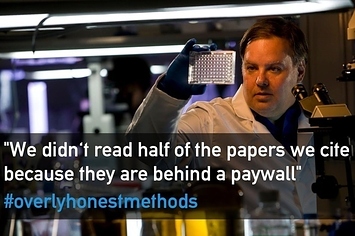
On a one year trial basis, in late 2014 Nature.com launched a potentially ‘interesting’ initiative which they called #scishare – Press Release
In December 2014, a 12-month content sharing trial was set up to enable subscribers to 49 journals on nature.com to legitimately and conveniently share the full text of articles of interest with colleagues without a subscription via a shareable web link on nature.com, enabled by publishing technology company, ReadCube. The trial was also extended to 100 media outlets and blogs around the world that report on the findings of articles published on nature.com, allowing them to provide their own readers with a link to a full text, read-only view of the original scientific paper.
Shortly after the launch, a number of people turned to social media/blogs to express their views.
On ReadCube, and Nature‘s give-away – Mike Taylor
Why Nature’s “SciShare” experiment is bad for altmetrics – Impactstory
Nature’s Shareware Moment – John Wilbanks
High-priced research publishers warily open up to the Web
Open access and the direction of travel in scholarly publishing – Stephen Curry
Macmillan may now offer ‘free access’, but is it really open?– Martin Eve
Some were of the view that Nature.com were making subscription based content Open Access which they were not.
Content sharing is *not* #openaccess and why @npgnews is committed to both http://t.co/vAkktFgxIM #SciShare
— Amy Bourke-Waite (@AmyJaneBourke) December 8, 2014
Content sharing is *not* open access and why NPG is committed to both
Nature.com content sharing: action and reaction – Timo Hannay
Clearing Up Misperceptions About Nature.com Content Sharing
There was a lot of discussion about all of this at the following Reddit thread.
The results of the trial were released in December 2015 – Press Release
Some of the ‘key’ findings (emphasis in bold mine):-
• The most popular method of sharing of scientific articles has been via the media and blogger referral programme, which gave readers of articles free, read-only access to the full text of scientific articles in news stories and posts. (77%)
• High-profile media reports of Nature journal articles from a plethora of international media outlets drove the most traffic of the trial. The most popular article of 2015 was, “A new antibiotic kills pathogens without detectable resistance” published in Nature in January 2015.
• In order, the most popular news outlets were: the BBC, the Guardian, the New York Times, Science Magazine and the Washington Post.
• Peer to peer sharing, where subscribers send or post shareable links to journal articles on nature.com tended to be mostly (67%) between subscribers and non-subscribers, with the remainder mainly accounted for by sharing between those who already had subscription access.
• The trial had no adverse implications for subscription-based journals either in terms of institutional business or individual article sales.
• The free read-only links were shared all across the globe but the most active sharing was instigated by subscribers in: the USA, the UK, Japan, Germany, China, Canada, Spain, France, India and the Republic of Korea.
In March 2016, it was announced that Springer Nature were set to extend content sharing to the entire Springer Nature-owned journal portfolio – Press Release
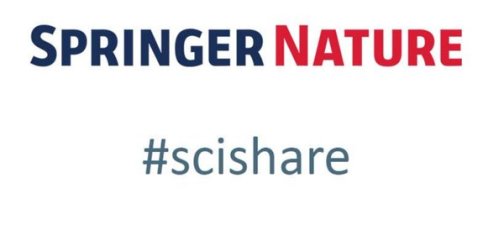
Springer Nature will provide authors with free, shareable links to view-only versions of their peer-reviewed research papers, starting with authors of Nature and the Nature research journals. This initiative will then be extended to authors of all other Springer Nature-owned primary research journals, and ultimately to all authors of Springer Nature published primary research journals. These links can be posted anywhere, including via social channels and on other highly-used sites, institutional repositories and authors’ own websites, as well as scholarly collaborative networks, which many researchers are using to collaborate and to share both publicly and privately. These sharing services are expected to be operational within the next two months for all Springer Nature-owned primary research titles, with sharing services for additional portfolio titles to follow once agreed with their owners in the following months.
The range of media partners enabled to use this sharing facility will also be extended. These media partners already represent over 100 other sites, many aimed at the public, including TheBBC, The Economist, Wired and The New York Times, as well as many leading science bloggers.
The tools that enable the content sharing initiative are provided by ReadCube, whose industry-leading functionality enables sharers to make available final published versions of research papers in the streaming Enhanced PDF format. In addition to the full text of the articles the Enhanced PDF provides hyperlinked in-line citations and figures, annotation capabilities, one-click access to supplemental content and figures and advanced article metrics.
Beyond these measures, Springer Nature plans additional steps to further extend sharing options which address the long-term needs of the research community.
I for one was having various technical issues getting this to work in practice.
Having spent 2 hours trying to test out legit access share read-only Springer content via @readcube, it doesn’t work #scishare #cantscishare
— ⓪ Grⓐhⓐm Steel 🔬🎓 (@McDawg) March 22, 2016
@McDawg We’ve been actively looking into the issue. It’s not something we were able to replicate so it’s taken us a bit longer to unravel.
— ReadCube (@readcube) March 22, 2016
At that time, it meant having to manually download a paper then manually uploading it to my library on ReadCube and then trying to find the sharable link which didn’t always work.
An example of when it did.
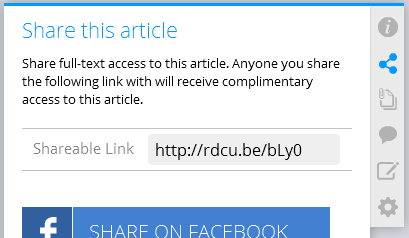
From a DRM perspective though, here’s what these shortened URLs actually look like in full
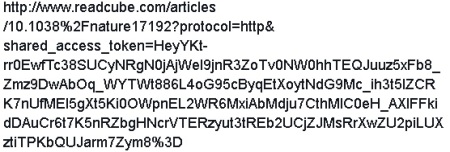
Devils Advocate
On the above point, I have to mention the following post by Dr Ross Mounce, March 2015 who has strong views on ReadCube.
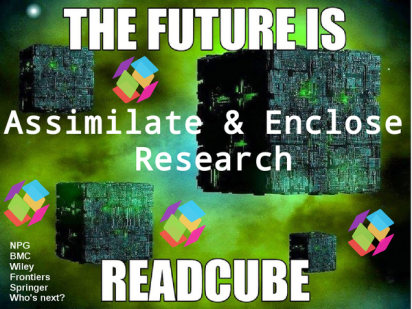
On October 17th 2016, following on from the earlier announcement in March above, Springer Nature did indeed roll this out on a much larger scale – Press Release
Springer Nature is delighted to announce that it has rolled out its free content sharing initiative, now named SharedIt, to all of the Springer Nature-owned portfolio and over one thousand additional co-owned and partner-owned journals. This now encompasses over 2,300 journals and enables authors and subscribers to post links to free-to-read versions of primary research articles anywhere, including social media platforms, repositories, websites, scholarly collaborative networks and via emails. It follows a successful trial and roll out of the initiative for research articles in Nature-branded journals which has resulted in over 2.2 million additional article views since its launch in December 2014.
“As the first publisher to trial free sharing of subscription journal articles back in December 2014 via a new service now named SharedIt, we were confident that our initiative would be a useful service to our authors and subscribers, which was why we took the bold step to trial it. Uptake of the service and the positive feedback we have received since then clearly demonstrate that there is a need – and a real appetite – for a simple, quick and legitimate way to share research in the academic community. This led us to the decision to invest in extending SharedIt across the entire portfolio, in combination with our partners at ReadCube,” said Steven Inchcoombe, Chief Publishing Officer at Springer Nature. “We believe that SharedIt is particularly beneficial because, unlike when PDFs or paper versions of research are circulated, the SharedIt links ensure that the most up to date, online version of the article is accessed, as well as providing valuable information to librarians, our authors and the wider community about how content is being utilised.”
Thrilled that @SpringerNature has launched SharedIt to extend content sharing to its entire collection! #scisharehttps://t.co/8grc7Wdlvi
— ReadCube (@readcube) October 17, 2016
After this was confirmed, I thought I would revisit the issue of how easy or not it was to share content since the last time I had tried. Initially, I thought not much had changed as in you still had to manually download papers and upload to ReadCube.
Anyone else still having technical issues getting #scishare to actually work in practice ? — ⓪ Grⓐhⓐm Steel 🔬🎓 (@McDawg) October 20, 2016
@nresearchnews Is there a video tutorial ? Still takes me about 10 minutes to create a sharable link after months of trying @readcube
— ⓪ Grⓐhⓐm Steel 🔬🎓 (@McDawg) October 18, 2016
No response to those tweets.
I was pleased? to note however that things have indeed changed….but….
without any announcement as how to do it ????
Personal communication:-
‘Even with the Nature implementation – there was no real education effort once it went live which was a shame. Unless you knew to click the “share” icon – you didn’t know it was there’.
Totally random Springer Nature papers accessed – October 20th 2016.
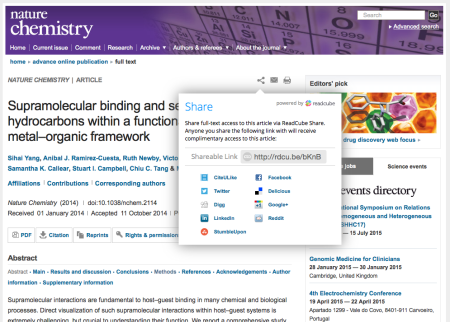

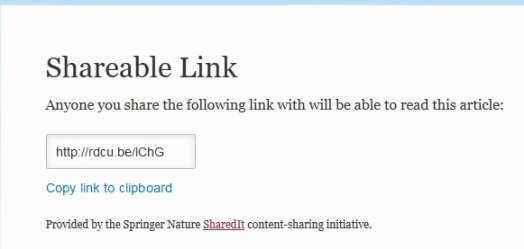
The point being that sharable links are now there automatically, no longer any need to faff around with downloading and uploading papers to create them.
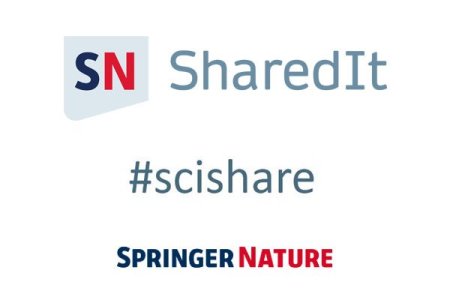
peer reviewed: I think you mean “… to our entire portfolio of closed access journals!” #scisharehttps://t.co/NCWfW4pwWP
— Egon Willighⓐgen (@egonwillighagen) October 17, 2016
As matters stand though, it would appear that Springer Nature don’t really want you to know how simple this now is.
On a lighter note to end with…
@McDawg “responsibly” “sustainably” uselessly
— Penny Andrews (@pennyb) October 28, 2016
+++UPDATE+++
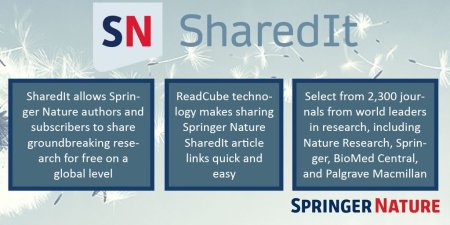
Since writing the above, Springer Nature have now * put out the following resources which provide the needed clarity !
* After I put in a request for this with folks from Springer Nature in person.
+++UPDATE2+++
VIDEO !
+++UPDATE3+++
ANOTHER VIDEO
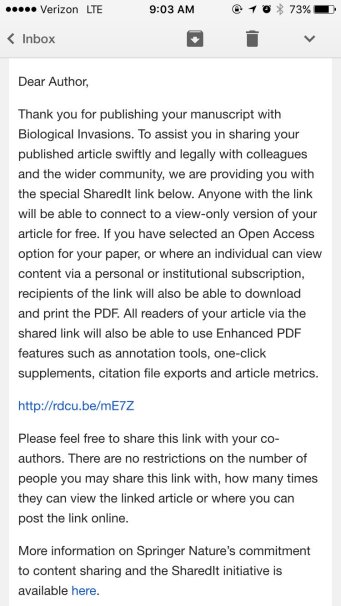
new springerlink for open access to read only manuscripts and no restrictions on link sharing!! #openscience https://t.co/q3C3RkiCeW pic.twitter.com/X3Y1E1Ir7x
— Jessica L. Burnett (@TrashBirdEcol) November 15, 2016
@TrashBirdEcol read only access is better than no access but this isn’t #openscience pic.twitter.com/DrtnCw1oEi
— ⓪ Grⓐhⓐm Steel 🔬🎓 (@McDawg) November 15, 2016
@McDawg Sure, it’s not as open as full access and sharing rights to all, but this is pretty damn close, IMHO.
— Jessica L. Burnett (@TrashBirdEcol) November 16, 2016



